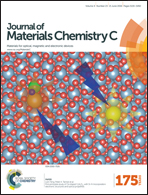Donor–acceptor conjugated polymers based on thieno[3,2-b]indole (TI) and 2,1,3-benzothiadiazole (BT) for high efficiency polymer solar cells†
Abstract
A universal synthetic strategy toward thieno[3,2-b]indole (TI) derivatives was developed. Three conjugated polymers (PTIBT, PTITBT and PTIDTBT) containing N-alkyl-TI as the donor units, 2,1,3-benzodiathiazole (BT) as the acceptor units and thiophene as the spacers were synthesized. The thiophene spacers have a dramatic impact on the physical and electrochemical properties of these copolymers. These polymer donors were used for the fabrication of bulk heterojunction polymer solar cells (PSCs). Preliminarily, power conversion efficiencies (PCEs) based on the device structure of ITO/PEDOT:PSS/polymer:PC71BM/Ca/Al exhibit a large distinction (1.61% for PTIBT, 5.83% for PTITBT and 1.79% for PTIDTBT) at optimal device fabrication conditions. The device based on PTITBT : PC71BM (1 : 3, w/w) shows the best PCE of 5.83% (Voc = 0.69 V, Jsc = 13.92 mA cm−2, FF = 61.8%), which represents one of the best performances among PCDTBT analogues. In addition, the Jsc of 13.92 mA cm−2 is also among the highest Jsc values of all PCDTBT analogues. On the basis of our results, one can conclude that incorporating TI and its derivatives into donor–acceptor conjugated polymers is a feasible and effective way to develop novel donor materials for high efficiency PSC applications.
![Graphical abstract: Donor–acceptor conjugated polymers based on thieno[3,2-b]indole (TI) and 2,1,3-benzothiadiazole (BT) for high efficiency polymer solar cells](/en/Image/Get?imageInfo.ImageType=GA&imageInfo.ImageIdentifier.ManuscriptID=C6TC00929H&imageInfo.ImageIdentifier.Year=2016)

 Please wait while we load your content...
Please wait while we load your content...